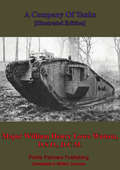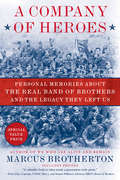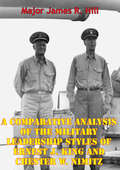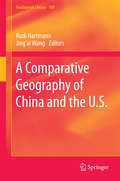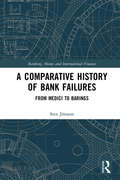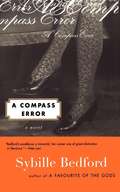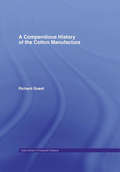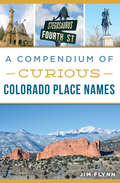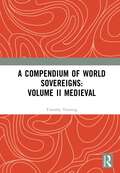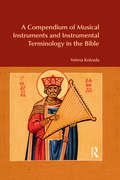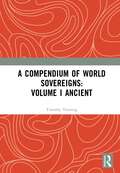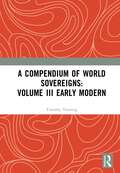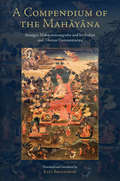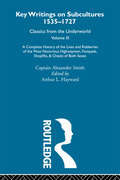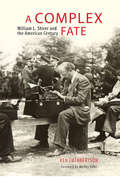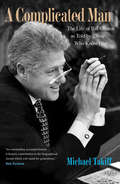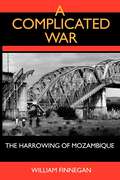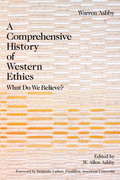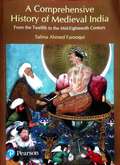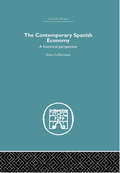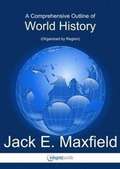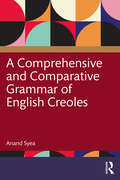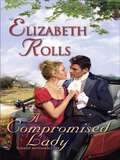- Table View
- List View
A Company Of Tanks [Illustrated Edition]
by Major William Henry Lowe Watson, D.S.O., D.C.M."Steel, mud, blood and courage on the Western FrontThis is a fine book because it is a superb first hand eye-witness account of British Tanks in action throughout the First World War. Without much preamble Watson launches the reader, in company with the author's brother officers, men and machines into the heart of the field of conflict on the 11th Corps forward line on the Western Front in the Autumn and Winter of 1916. From that point to the end of the book and the war itself the narrative takes us inexorably into the dark heart of war the tankers knew. Battles and battlefield experiences in their various phases (sometimes the book includes descriptions as expansive as three chapters each) are covered in engrossing detail. We join the author and the men we come to know as personalities, at First and Second Bullecourt, in much detail at Third Ypres and Cambrai before Amiens, the breaking of the Hindenburg Line and Second Le Cateau. This is a primary source work within a finite resource and as such is beyond value. Nevertheless, it is also a highly absorbing read to be relished by students of the period-professional and amateur alike. Available in soft cover and hard back with dust jacket for collectors."-Leonaur Print VersionAuthor -- Major William Henry Lowe Watson, D.S.O., D.C.M. (1891-1931)Text taken, whole and complete, from the edition published in Edinburgh; William Blackwood, 1920.Original Page Count - vii and 296 pagesMaps -- 8 sketch maps.
A Company of Heroes: Personal Memories about the Real Band of Brothers and the Legacy They Left Us
by Marcus BrothertonTHE "MUST-READ"* BOOK THAT INSPIRED THE EXTRAORDINARY DOCUMENTARY FOR PUBLIC TELEVISION After the Band of Brothers went home, they never forgot the lessons of war... After chronicling the personal stories of the Band of Brothers in We Who Are Alive and Remain, author Marcus Brotherton presents a collection of remembrances from the families of the soldiers of Easy Company--and how their wartime experiences shaped their lives off the battlefield. A Company of Heroes is an intimate, revealing portrait of the lives of the men who fought for our freedom during some of the darkest days the world has ever known--men who returned home with a newfound wisdom and honor that they passed onto their families, and that continue to inspire new generations of Americans. *Jake Powers, Official E/506th Historian
A Company of Swans
by Eva IbbotsonFor 19-year-old Harriet Morton, life in 1912 Cambridge is dull. Her stuffy father and her oppressive aunt Louisa allow her only one outlet: ballet. When a Russian ballet master comes to class searching for dancers to fill the corps of his ballet company before their South American tour, Harriet's world changes.
A Comparative Analysis Of The Military Leadership Styles Of Ernest J. King And Chester W. Nimitz
by Major James R. HillIn a constantly changing world threatened by the likelihood of terrorist acts, the American people need military leaders who clearly demonstrate an understanding of American core values, and who are both competent and morally focused. In order to produce military leaders who meet these qualifications and who can successfully meet the future challenges America faces, it is important to develop and refine those leaders early and help them understand how to create and refine a successful leadership style. The process of developing leadership styles, however, is not easy and it requires a prodigious amount of determination, time, and planning from prospective future leaders. It also requires military training institutions to align their curriculums to promote leadership, as well as, to provide guidance and mentoring in order to help develop these future leaders.One way to help develop leaders is to provide examples of both successful and flawed military leadership styles. There are many cases of each in American history. In particular, World War II leaders Admirals Ernest J. King and Chester W. Nimitz provide contrasting examples of naval leadership. An examination of the leadership styles of these two naval officers provides useful examples which future leaders can consider when reflecting on their own leadership styles. After careful review, it soon becomes evident that the leadership style of Nimitz closely aligned with the leadership styles of Generals George C. Marshall and Dwight D. Eisenhower, two World War II leaders I closely examined in my previous Master's thesis. In addition, it also becomes evident that King was a diametrically different leader from these three leaders. He provides an example of a leader who was cold, harsh, and morally bankrupt. As result, reviewing the leadership styles of these World War II leaders will benefit future leaders as well as those they lead.
A Comparative Geography of China and the U.S. (GeoJournal Library #109)
by Rudi Hartmann Jing'Ai Wang Tao YeThe book is the outcome of a unique venture: a team of Chinese geographers and a team of American geographers collaborated on a new Comparative Geography of China and the United States. The book meets a high demand for comparative information about China and the United States, as the home of the two leading economies in a globalizing world. Comparisons of the two countries include the similarities and differences in their physical environments and natural hazards, the growth and changing spatial distribution of population and ethnic groups in China and the U. S. , traditions and contemporary regional expressions of agriculture and food production as well as the rapidly changing urban and industrial patterns in both countries. The book also highlights the two countries' interconnectedness, in trade and in the exchange of cultural, social, scientific & technological information. The volume serves as a major resource in geographic education as it contributes to a better and more comprehensive understanding of the formation and development of the two countries' basic geographical patterns and processes.
A Comparative History of Bank Failures: From Medici to Barings (Banking, Money and International Finance)
by Sten JonssonStarting with Medici and Fugger and ending with Barings and Royal Bank of Scotland under neo-liberal de-regulation, the author gives an account of how a number of banks failed over a 500 year-period. The author offers an explanation of the leading ideas about the world and good society at the time, and summarizes this narrative using Streeck & Schmitter’s three bases for regulation of society: Community (spontaneous solidarity), State (hierarchical control), and Market (dispersed competition). <P><P>The bank failures are presented in the context of social philosophies of the day (scholasticism, mercantilism, neo-liberalism, and libertarianism), and the changing business practices (Bills of Exchange, rents and financial instruments of various kinds). The dominating explanation of financial crises has been market-related. Here, the author argues that managerial failures are an important contributor. He demonstrates the failure of management to act on early signals such as existential risk, strategic stress syndrome, and lack of proper oversight by top management. The author encourages a return to ethical principles for banks, suggesting that his ethical aspect should be at the core of the credit process of banks in the future. <P><P>With its interdisciplinary approach, this book will be an important contribution to the discussion surrounding bank failures. It will interest any scholar looking at the origins of financial crises and will be particularly useful for post-graduate students of economic and financial history, banking, finance and accounting.
A Compass Error
by Sybille BedfordFirst published in 1968. In this sequel to The Favourite of the Gods, seventeen-year-old Flavia, on her own in the south of France in the late 1930s, lives with the confidence and ardor of youth. She knows her destiny-it lies at Oxford, where she will begin a great career of public service. But this view of herself is at odds with reality; it springs from ideas she has of her idolized English father and of her blessed Italian mother, Constanza. Only when she is caught up in an intrigue that is to determine the fate of those she most loves does she begins to discover her own true nature-even as she loses the bearings of her moral compass.
A Compendious History of Cotton Manufacture: With A Disproval Of The Claim Of Sir Richard Arkwright To The Invention Of Its Ingenious Machinery -
by Richard GuestFirst Published in 1968. Routledge is an imprint of Taylor & Francis, an informa company.
A Compendium of Curious Colorado Place Names (History & Guide)
by Jim FlynnThe origins of Colorado place names offer insightful glimpses into the state's formative years. Emanuel Saltiel named his new community along the Arkansas River Cotopaxi, after a volcano in Ecuador. Rifle Creek and the town of Rifle earned their names thanks to a rifle left behind along the banks of the creek. Optimistic miners mistakenly believed Tarryall had an abundance of gold and thus named it as a place where prospectors could mine and tarry. And despite attempts by government officials to rename a small community along the I-70 corridor in western Colorado, locals refused to call it anything other than No Name. Learn these stories and more as author Jim Flynn unravels the intriguing origins of Centennial State place names.
A Compendium of Medieval World Sovereigns
by Timothy VenningThe Compendium of World Sovereigns series contains three volumes: Ancient, Medieval, and Early Modern. These volumes provide students with easy-to-access ‘who’s who’ with details on the identities and dates, ages and wives, where known, of heads of government in any given state at any time within the framework of reference. The relevant original and secondary sources are also listed in a comprehensive bibliography. The text provides a clear reference guide for students to who was who and when they ruled in the dynasties and other ruler-lists for the Ancient, Medieval, and Early Modern worlds – primarily European and Middle Eastern but including available information on Africa and Asia and the pre-Columbian Americas. The trilogy accesses and interprets the original data plus any modern controversies and disputes over names and dating, reflecting on the shifts in and widening of focus in student and academic studies. Each volume contains league tables of rulers’ ‘records’, and an extensive bibliographical guide to the relevant personnel and dynasties, plus any controversies, so readers can consult these for extra details and know exactly where to go for which information. All relevant information is collected and provided as a one-stop-shop for students wishing to check the known information about a world Sovereign. The Medieval volume begins with the Byzantine Empire and moves through the Crusader States, the Islamic World, South and East Asia, Africa, the Mediterranean, and lastly Western and Eastern Europe. Compendium of World Sovereigns: Volume II Medieval provides students and scholars with the perfect reference guide to support their studies and to fact check dates, people, and places.
A Compendium of Musical Instruments and Instrumental Terminology in the Bible
by Yelena Kolyada'A Compendium of Musical Instruments and Instrumental Terminology in the Bible' draws on extensive historical research, comparative linguistic analysis and musical study to offer the first compilation of its kind. The volume examines the entire range of musical instruments in the Bible - stringed, wind and percussion - drawing on ancient and modern translations of the Bible and the works of rabbinic teachers, Church Fathers and medieval, renaissance and contemporary scholars. The book offers a historical survey of Hebrew instrumental music - its origins and links with neighbouring cultures, the role of instruments in the religious, social, public and private life of ancient Israel, and the system of musical education - and explores the understanding of Hebrew musical instruments in post-biblical times. This comprehensive volume will be invaluable to musicologists, archaeologists, theologians, historians, philologists and Bible translators, as well as general readers in the subject.
A Compendium of World Sovereigns: Volume I Ancient
by Timothy VenningThe Compendium of World Sovereigns series contains three volumes: Ancient, Medieval, and Early Modern. These volumes provide students with easy-to-access ‘who’s who’ with details on the identities and dates, ages and wives, where known, of heads of government in any given state at any time within the framework of reference. The relevant original and secondary sources are also listed in a comprehensive bibliography. Providing a clear reference guide for students, to who was who and when they ruled in the dynasties and other ruler-lists for the Ancient, Medieval, and Early Modern worlds – primarily European and Middle Eastern but including available information on Africa and Asia and the pre-Columbian Americas. The trilogy accesses and interprets the original data plus any modern controversies and disputes over names and dating, reflecting on the shifts and widening of focus in student and academic studies. Each volume contains league tables of rulers’ ‘records’, and an extensive bibliographical guide to the relevant personnel and dynasties, plus any controversies, so readers can consult these for extra details and know exactly where to go for which information. All relevant information is collected and provided as a one-stop-shop for students wishing to check the known information about a world Sovereign. The Ancient volume begins with the Pharaohs in Egypt and moves through Greece, Classical and Early Medieval Armenia, Crimea, Syria, Jordan, Israel and Judah, Persia, India and ends with the Roman World in the east and west. A Compendium of World Sovereigns: Volume I Ancient provides students and scholars with the perfect reference guide to support their studies and to fact check dates, people, and places.
A Compendium of World Sovereigns: Volume III Early Modern
by Timothy VenningThe Compendium of World Sovereigns series contains three volumes: Ancient, Medieval, and Early Modern. These volumes provide students with easy-to-access ‘who’s who’ with details on the identities and dates, ages and wives, where known, of heads of government in any given state at any time within the framework of reference. The relevant original and secondary sources are also listed in a comprehensive bibliography. Providing a clear reference guide for students, to who was who and when they ruled in the dynasties and other ruler-lists for the Ancient, Medieval, and Early Modern worlds – primarily European and Middle Eastern but including available information on Africa and Asia and the pre-Columbian Americas. The trilogy accesses and interprets the original data plus any modern controversies and disputes over names and dating, reflecting on the shifts and widening of focus in student and academic studies. Each volume contains league tables of rulers’ ‘records’, and an extensive bibliographical guide to the relevant personnel and dynasties, plus any controversies, so readers can consult these for extra details and know exactly where to go for which information. All relevant information is collected and provided as a one-stop-shop for students wishing to check the known information about a world Sovereign. The Early Modern volume begins with Eastern and Western Europe and moves through the Ottoman Empire, South and East Asia, Africa, and ends in Central and South America. Compendium of World Sovereigns: Volume III Early Modern provides students and scholars with the perfect reference guide to support their studies and to fact check dates, people, and places.
A Compendium of the Mahayana: Asanga's Mahayanasamgraha and Its Indian and Tibetan Commentaries (Tsadra)
by AsangaThe first complete English translation of Asanga's Mahayanasamgraha, the most important and comprehensive Indian Yogacara text, and all its available Indian commentaries.The Mahāyānasaṃgraha, published here with its Indian and Tibetan commentaries in three volumes, presents virtually everything anybody might want to know about the Yogācāra School of mahāyāna Buddhism. It discusses in detail the nature and operation of the eight kinds of consciousness, the often-misunderstood notion of “mind only” (cittamātra), dependent origination, the cultivation of the path and its fruition in terms of the four wisdoms, and the three bodies (kāyas) of a buddha.Volume 1 presents the translation of the Mahāyānasaṃgraha along with a commentary by Vasubandhu. The introduction gives an overview of the text and its Indian and Tibetan commentaries, and explains in detail two crucial elements of the Yogācāra view: the ālaya-consciousness and the afflicted mind (kliṣṭamanas).Volume 2 presents translations of the commentary by Asvabhāva and an anonymous Indian commentary on the first chapter of the text. These translations are supplemented in the endnotes by excerpts from Tibetan commentaries and related passages in other Indian and Chinese Yogācāra works.Volume 3 includes appendices with excerpts from other Indian and Chinese Yogācāra texts and supplementary materials on major Yogācāra topics in the Mahāyānasaṃgraha.
A Complete History of the Lives and Robberies of the Most Notorious Highwaymen, Footpads, Shoplifts and Cheats of Both Sexes: Previously published 1719 and 1926 (Key Writings On Subcultures, 1535-1727 Ser. #Vol. 3)
by Captain Alexander SmithA Complete History of the Highwaymen discloses the most secret and barbarous murders, unparalleled robberies, notorious thefts and unheard of cheats, setting them in a true light and exposing them to public view for the common benefit of mankind. The accounts and confessions are drawn from imprisoned villains who awaited their fate at the gallows. This reprint makes available the 1926 reissue of Captain Smith's fifth edition and includes an introduction by Arthur L. Hayward, which sets the accounts in the appropriate historical context.
A Complex Fate: William L. Shirer and the American Century (ISSN)
by Ken CuthbertsonWilliam Shirer (1904-1993), a star foreign correspondent with the Chicago Tribune in the 1920s and ’30s, was a prominent member of what one contemporary observer described as an extraordinary band of American journalists, "some with the Midwest hayseed still in their hair," who gave their North American audiences a visceral sense of how Europe was spiralling into chaos and war. In 1937, Shirer left print journalism and became the first of the now legendary "Murrow boys," working as an on-air partner to the iconic CBS broadcaster Edward R. Murrow. With Shirer reporting from inside Nazi Germany and Murrow from blitz-ravaged London, the pair built CBS’s European news operation into the industry leader and, in the process, revolutionized broadcasting. But after the war ended, the Shirer-Murrow relationship shattered. Shirer lost his job and by 1950 found himself blacklisted as a supposed Communist sympathizer. After nearly a decade in the professional wilderness, he began work on The Rise and Fall of the Third Reich. Published in 1960, Shirer's magnum opus sold millions of copies and was hailed as the masterwork that would "ensure his reputation as long as humankind reads." Ken Cuthbertson's A Complex Fate is a thought-provoking, richly detailed biography of William Shirer. Written with the full cooperation of Shirer’s family, and generously illustrated with photographs, it introduces a new generation of readers to a supremely talented, complex writer, while placing into historical context some of the pivotal media developments of our time.
A Complicated Man: The Life of Bill Clinton as Told by Those Who Know Him
by Michael Takiff&“An astonishing collection of 171 interviews with Clinton&’s friends, foes, admirers, and detractors as well as reporters and political analysts.&”—Booklist (starred review). Though Bill Clinton has been out of office since 2001, public fascination with him continues unabated. Many books about Clinton have been published in recent years, but shockingly, no single-volume biography covers the full scope of Clinton&’s life from the cradle to the present day, not even Clinton&’s own account, My Life. More troubling still, books on Clinton have tended to be highly polarized, casting the former president in an overly positive or negative light. In this, the first complete oral history of Clinton&’s life, historian Michael Takiff presents the first truly balanced book on one of our nation&’s most controversial and fascinating presidents. Through more than 150 chronologically arranged interviews with key figures—including Bob Dole, James Carville, and Tom Brokaw, among many others—A Complicated Man goes far beyond the well-worn party-line territory to capture the larger-than-life essence of Clinton the man. With the tremendous attention given to the Lewinsky scandal, it is easy to overlook the president&’s humble upbringing, as well as his many achievements at home and abroad: the longest economic boom in American history, a balanced budget, successful intervention in the Balkans, and a series of landmark, if controversial, free-trade agreements. Through the candid recollections of Takiff&’s many subjects, A Complicated Man leaves no area unexplored, revealing the most complete and unexpected portrait of our forty-second president published to date. &“Packed with fascinating personal perspective and testimony.&”—Nigel Hamilton, bestselling and award-winning author of American Caesars
A Complicated War: The Harrowing of Mozambique (Perspectives on Southern Africa #47)
by William FinneganPowerful, instructive, and full of humanity, this book challenges the current understanding of the war that has turned Mozambique—a naturally rich country—into the world's poorest nation. Before going to Mozambique, William Finnegan saw the war, like so many foreign observers, through a South African lens, viewing the conflict as apartheid's "forward defense." This lens was shattered by what he witnessed and what he heard from Mozambicans, especially those who had lived with the bandidos armado, the "armed bandits" otherwise known as the Renamo rebels. The shifting, wrenching, ground-level stories that people told combine to form an account of the war more local and nuanced, more complex, more African—than anything that has been politically convenient to describe.A Complicated War combines frontline reporting, personal narrative, political analysis, and comparative scholarship to present a picture of a Mozambique harrowed by profound local conflicts—ethnic, religious, political and personal. Finnegan writes that South Africa's domination and destabilization are basic elements of Mozambique's plight, but he offers a subtle description and analysis that will allow us to see the post-apartheid region from a new, more realistic, if less comfortable, point of view.
A Comprehensive History Of Western Ethics
by Warren AshbyOur intellectual history spans more than 2,000 years, yet, surprisingly, we have had no adequate history of Western ethics. A Comprehensive History of Western Ethics fills this void by providing an engaging, thorough, and inclusive history that encompasses both classical and modern perspectives. Author Warren Ashby speaks both to students of history and ethics and to a public interested in but often perplexed by moral values in contemporary life. Ashby embraces all who are concerned with expanding human rights, finding new ways to think about moral experience, and discovering an ethical perspective appropriate for their lives. By exploring past ethical problems, we can prepare for the future's challenges.Included with the commentary on the writings of great thinkers are in-depth discussions of Greek, biblical, and Stoic ethics; Augustine, Aquinas, and medieval views; the Renaissance, the Reformation, and ethics in the age of science; as well as the Enlightenment, Romanticism, and the last Western century.
A Comprehensive History of Medieval India: From the Twelfth to the Mid-Eighteenth Century
by Salma Ahmed Farooqui"A Comprehensive History of Medieval India From the Twelfth to the Mid-Eighteenth Century" by Salma Ahmed Farooqui provides a detailed exploration of the socio-political, economic, and cultural developments in medieval India. Farooqui meticulously examines the period from the 12th to the mid-18th century, covering the rise and fall of various dynasties, the impact of invasions and conquests, and the transformation of society and administration. The book delves into the rich tapestry of medieval Indian history, addressing key events such as the Delhi Sultanate, the Mughal Empire, and the regional kingdoms. It also sheds light on the interactions between different religious and cultural communities, providing a nuanced understanding of the diverse and complex dynamics that shaped this crucial era in Indian history.
A Comprehensive History of the Woollen and Worsted Manufacturers: A Historical Perspective
by J. BischoffFirst Published in 1968. Routledge is an imprint of Taylor & Francis, an informa company.
A Comprehensive Outline of World History
by Jack MaxfieldThis course presents Jack E. Maxfield's "A Comprehensive Outline of World History" as originally organized, chronologically by era and across regions within an era.
A Comprehensive and Comparative Grammar of English Creoles
by Anand SyeaA Comprehensive and Comparative Grammar of English Creoles provides a detailed, comprehensive description of the morphology, grammar, and syntax of a selected number of English creoles, including those spoken on both sides of the Atlantic and the Pacific. This book: • Focuses on a number of traditional grammatical categories to provide a comprehensive description and discussion of these languages; • Identifies not only how creoles differ from their lexifier, but also how they differ from one another; • Provides effective comparative descriptions to enable an insightful understanding of language evolution. This book will be ideal supplementary reading for students and researchers of linguistics, and will particularly appeal to those with an interest in descriptive linguistics, historical linguistics, World Englishes, contact and creole linguistics, and language policy and planning.
A Compromised Innocent
by Elaine GoldenUnder intense pressure to secure a marriage contract, Miss Lizzie Talbot doesn't dare hope that handsome Oliver Fortney, Duke of Wainsborough, would ever be interested in her. Though she longs to know his taste and touch, he is far above her station. So Lizzie is shocked when Oliver promises to show her pleasure she never imagined… Yet she doesn't expect more than a brief dalliance. For Oliver is destined for a match of importance and wealth, neither of which Lizzie can offer…
A Compromised Lady
by Elizabeth RollsA woman forced to marry for her inheritance fears revealing her dark past to her prospective husband in this Regency romance.As a girl she had been bubbling over with mischief.As a woman she seemed half lost in shadow. But Richard Blakehurst couldn’t miss the flash of connection between them when his hand touched hers. It was as if he had awakened something deep inside her.Seeing Richard again brought back the taunting memory of their dance at her coming-out ball. She must tame her wayward thoughts, because Thea doubted even her considerable fortune could buy Richard’s good opinion of her if ever he learnt the truth. . . .
